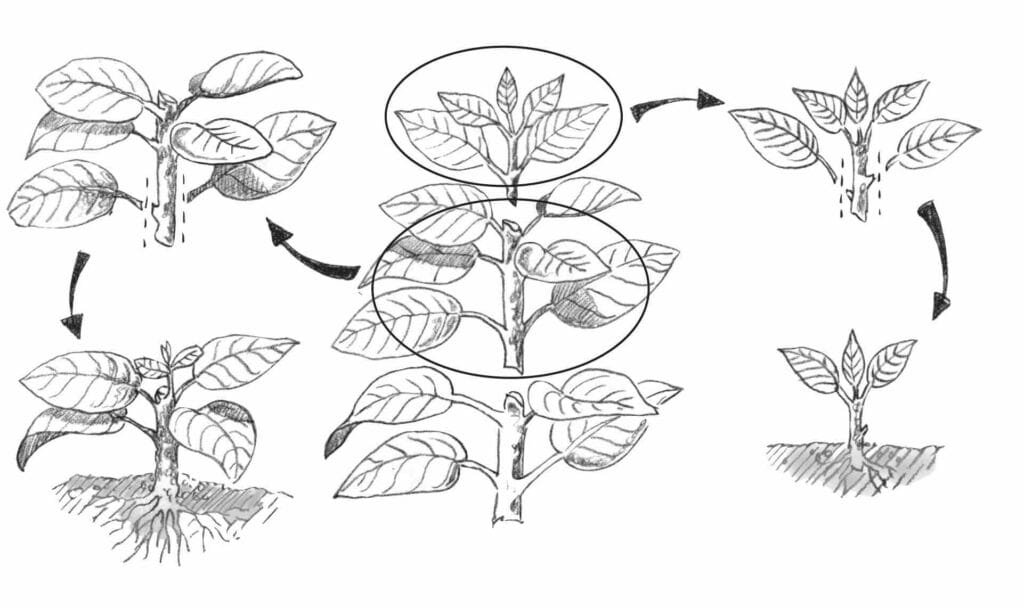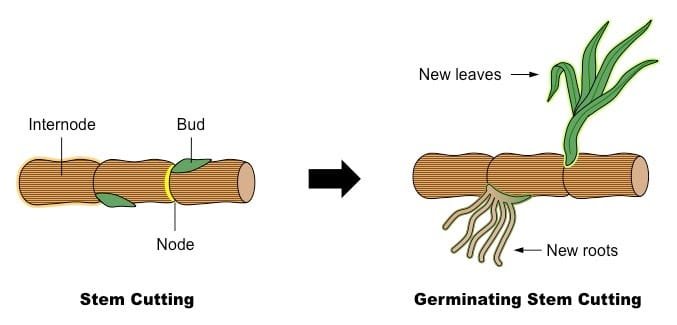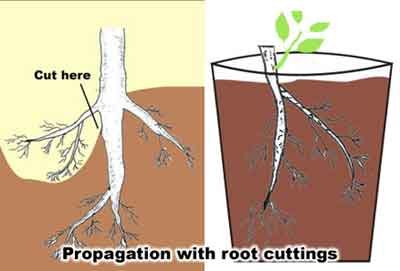1. Introduction to Cutting Method of Vegetative Propagation
The cutting method is one of the most widely used and effective forms of vegetative propagation. This technique involves taking a part of a parent plant, such as a stem, root, or leaf, and encouraging it to grow into a new, genetically identical plant. It is a simple, cost-effective, and time-saving method commonly employed in horticulture, agriculture, and gardening. Unlike propagation through seeds, which may result in genetic variation, propagation by cutting ensures uniformity and preservation of desirable traits in plants. This method is especially useful for reproducing ornamental plants, fruit trees, shrubs, and other plants that do not reliably produce seeds.

Cuttings allow for rapid multiplication of plants with minimal input and space. The success of this method depends on several factors such as the type of cutting, the parent plant’s health, environmental conditions, and proper care during rooting. In this comprehensive guide, we will explore the types, techniques, advantages, and essential care required for propagation by cuttings, along with commonly propagated plant species.
Summary of Cutting Method
- Cutting ensures rapid, cost-effective cloning of mature plants, using stem, leaf, or root pieces to grow genetically identical offspring.
- It guarantees uniformity and quicker establishment, making it ideal for ornamentals, fruit trees, and plants that don’t produce viable seeds.
- Success depends on timing, rooting medium, hormones, and environmental control, making cuttings a powerful yet precise tool in horticulture
Table of Contents
2. Concept and Importance of Vegetative Propagation by Cutting Method
2.1 Definition and Principle
Vegetative propagation by cutting refers to the process of growing new plants from vegetative parts such as stems, roots, or leaves. The principle lies in the plant’s natural ability to regenerate tissues and form roots under favorable conditions. This process ensures that the new plant is genetically identical to the parent.
2.2 Importance and Uses
Propagation by cutting offers numerous benefits including rapid multiplication of plants, preservation of desirable traits, and cost efficiency. It is widely used in nurseries for mass production and in conservation practices to maintain rare or endangered species. It’s also ideal for commercial floriculture and landscape gardening.
3. Types of Plant Cuttings
3.1 Stem Cuttings

3.1.1 Herbaceous Stem Cuttings
Taken from non-woody plants, these cuttings are soft and green. They root easily and are commonly used for plants like coleus, basil, and chrysanthemums.
3.1.2 Softwood Cuttings
Collected from the soft, new growth of woody plants, these cuttings root quickly but require a humid environment. Examples include dogwoods, hydrangeas, and gardenias.
3.1.3 Semi-Hardwood Cuttings
These are taken from partially matured stems of shrubs and evergreens during late summer. They require rooting hormones and misting.
3.1.4 Hardwood Cuttings
Taken from mature, dormant woody stems during late fall or winter, these are more difficult to root but are used for grapes, figs, and pomegranates.
3.2 Leaf Cuttings
In this method, a whole leaf or a section of it is used to propagate new plants. Common in succulents like kalanchoe and snake plant.
3.3 Root Cuttings

This involves using pieces of roots to grow new plants. It is useful for plants like blackberry, horseradish, and phlox.
4. Process of Cutting Propagation
4.1 Selection of Mother Plant
Choose a healthy, disease-free parent plant with desirable traits. The plant should be mature and actively growing.
4.2 Preparing the Cutting
Cut a segment from the plant using sterilized tools. The length and type depend on the plant species. Remove lower leaves and make a clean cut below a node.
4.3 Treatment with Rooting Hormones
Dip the cut end in a rooting hormone to stimulate root formation and reduce rotting.
4.4 Planting the Cutting
Place the cutting in a well-drained medium such as sand, vermiculite, or perlite. Maintain adequate moisture and cover with plastic if needed to retain humidity.
4.5 Providing Ideal Conditions
Keep the cuttings in a warm, bright, and humid place. Avoid direct sunlight. Water gently and regularly to prevent wilting or fungal infections.
4.6 Transplanting the Rooted Cuttings
Once roots are well-developed, transplant the cuttings into pots or the field. Gradually acclimate them to outdoor conditions.
5. Advantages of Cutting Methods of Vegetable Propagation
1 Cost-Effective and Efficient
It requires minimal tools, no seeds, and low investment, making it economical.
2 Genetic Uniformity
Clones of the parent plant are produced, maintaining consistent traits and quality.
3 Faster Maturity
Cuttings establish quickly and grow faster than seed-grown plants.
4 Suitable for Difficult-to-Seed Plants
Plants that rarely flower or produce viable seeds can be propagated effectively.
6. Limitations and Challenges of Cutting Method
6.1 Limited Longevity
Clones may lack vigor and are prone to disease accumulation over generations.
6.2 Rooting Difficulties
Some species are hard to root or require special techniques.
6.3 Environmental Sensitivity
Success depends heavily on maintaining humidity, temperature, and moisture.
7. Commonly Propagated Plants by Cutting Method
The commonly propagated Plants by cutting Method,
7.1 Ornamental Plants
Rose, hibiscus, croton, coleus, and bougainvillea.
7.2 Fruit Plants
Grapes, fig, guava, pomegranate, and mulberry.
7.3 Medicinal and Aromatic Plants
Lemongrass, basil, mint, and rosemary.
8. Conclusion
The cutting method of vegetative propagation stands out as a versatile, cost-effective, and high-yield approach in modern horticulture. By using parts of a parent plant such as stems, leaves, or roots, growers can create genetically identical clones that preserve the parent’s favorable traits including ornamental beauty, fruit quality, or disease resistance. This method offers rapid establishment compared to seeds, allowing plants to mature faster, which is particularly valuable for commercial nurseries and home gardeners alike.
The process begins with selecting healthy, disease-free stock and preparing the cutting with careful trimming and hormone treatment. Rooting hormones like indole-3-butyric acid (IBA) significantly improve root initiation, especially in herbaceous or hardwood cuttings. Cuttings are then placed in suitable substrates, such as coir, perlite, or soil mixes with good moisture retention and aeration. Environmental parameters such as warmth, indirect light, and high humidity are crucial for preventing desiccation and promoting adventitious root growth.
While cuttings offer uniformity and efficiency, they are not without challenges. Some species are difficult to root due to physiological or environmental limitations. Moreover, clones can accumulate pathogens over successive generations, and rooting success can be sensitive to factors like medium quality and hormone use. Advanced techniques like aeroponics can overcome these constraints, allowing precise control of moisture and oxygen to boost success rates in difficult-to-propagate plants.
Overall, cutting propagation remains a cornerstone of sustainable horticulture. With a strategic approach involving proper stock selection, hormone application, optimal substrate, and controlled conditions, gardeners and growers can reliably multiply high-quality, uniform plants. The method’s simplicity, adaptability, and precision make it essential for preserving valuable cultivars, restoring biodiversity, and supporting scalable plant production in both home and commercial settings.
Frequently Asked Questions (FAQs)
What is plant propagation by cutting?
Plant propagation by cutting is a method of growing new plants from a part of the parent plant, such as a stem, leaf, or root. This technique produces genetically identical plants by encouraging root formation under controlled conditions like warmth and humidity.
What are the main types of cutting propagation?
The main types are stem cuttings, leaf cuttings, and root cuttings. Stem cuttings vary from softwood to hardwood, leaf cuttings are common in succulents, and root cuttings work well for plants like raspberries and figs.
How can I improve cutting rooting success?
Use healthy parent plants, apply rooting hormone, and plant in a moist, well-draining mix. Keep the environment warm and humid with indirect light to promote fast and healthy root growth.
Related Articles

